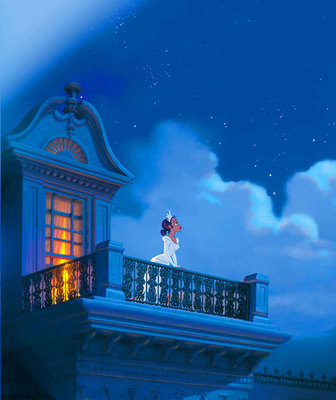 According to IMDB’s June 5th edition of Studio Briefing, Angelina Jolie brought up in public what many of us were thinking privately: Where in the world are Disney’s black princesses?
According to IMDB’s June 5th edition of Studio Briefing, Angelina Jolie brought up in public what many of us were thinking privately: Where in the world are Disney’s black princesses?
Disney has had Chinese, Native American, Middle Eastern, mermaid, and even Hawaiian heroines–not to mention its many dog, cat, and mouse heroines. And Latinas at least got The Three Caballeros, which featured such memorable female characters as “The Brazilian Girl,” “Mexico Girl #1,” and “Mexico Girl #2.” What about the sistahs? More importantly, as a white girl, am I even allowed to say “sistahs”?
Evidently Ms. Jolie didn’t know about Disney’s upcoming new animated feature, a film slated to arrive in more than a year and a half but has already gathered around itself much controversy.
In its original iteration, the new film, dubbed “The Frog Princess” after the famous folktale of the same name and set in 1920s New Orleans, featured a plucky African-American servant girl named Maddy who, with strength of heart and the help of a voodoo priestess, a jazz-singing crocodile, and a Cajun firefly, wins the heart of the noble prince and lives happily ever after.
The original story has the princess turn into a frog at some point, but information about that element of the plot has yet to be revealed.
Outrage ensued. Or, so I’m told. I googled “Frog Princess controversy” and read article after article about how “politically correct types” complained that the name “Maddy” was too low-class (don’t tell Ms. Albright) and sounded too much like “Mammy,” a name I’d give the Disney corporation a dollar to use just to watch the hilarity. These articles also claimed that some mothers complained on the Internet that a chambermaid was too low class a profession for a soon-to-be princess (don’t tell Cinderella). Apparently, someone railed against the title of the film (don’t ask me who; I’m just a rumor-monger) because of the “frog” part, although if you asked me why I couldn’t tell you.
I’m a little suspicious of these articles since not one of them links to any of these mysterious complaints, but I’d be very happy to see some evidence of these terrible PC moms if anyone can find some for me. The only person actually quoted was BET’s Jennifer Daniels, who maybe rightly took issue with the fact that the villain of the movie is an evil Magical Negro (Voodoo class), the frog princess’ prince was white, and the film’s music written by pasty-as-chalk Randy Newman.
While I don’t agree with all of these real or imagined grievances, I can understand them. After all, based on Disney’s track record with sensitive racial issues, I’d half-expect their Frog Princess to look something like this:
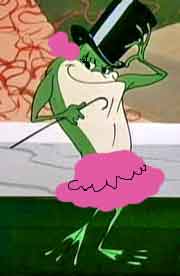
But Disney’s response annoys me, too. No longer is Maddy a simple chambermaid. Actually, no longer is Maddy Maddy! Fearing backlash, Disney decided to give its new protagonist a new sparkly rainbow Disney name: Princess Tiana, a name that I’m pretty sure no black woman in the 1920s would ever actually have. Baby Names World shows that this name didn’t even really exist until around 1970, reaching its peak in the mid-90s. I assume based on this information that Princess Tiana’s best friends in the film are Princesses Mackenzie, Autumn, and Breanna. For that matter, why not Princess Beyonce? I’m fairly sure Disney owns her soul, too, don’t they?
Okay, “The Frog Princess” was changed into the blander “The Princess and the Frog”–no biggie–but, more mysteriously, the love interest, once named Prince Harry, was suddenly switched to Prince Levine. So the Disney Corporation decided that instead of offending people by a wealthy WASP save the poor black girl, they’d have a wealthy Jew save her? That’s the big fix?
I realize the Disney writers, like all white writers, are navigating between Scylla and Charybdis here, with super-racism on one side and white-washing on the other. Before the second half of the 20th century, most white authors writing ethnic characters went the stereotype route. Jews had giant noses and hoarded cash. Asians had shifty eyes and would stab you in the back. Black characters had “negroid features” and “wooly hair” and wouldn’t know anything about birthin’ no baybays. Television in the 80s and 90s got better, as evil politically correct types in Hollywood started allowing African Americans on sitcoms. Of course, those characters went in the opposite direction. If you can find an episode of the Cosby Show in which any of the characters mentions issues of race, I’d love to see it. The Fresh Prince of Bel Air (which I’ve already mentioned in another post was created and written by white Jews) is an exception which proves the rule, since Will is only able to be a fish out of water because he is the only un-white-washed black character in the cast.
In America, unfortunately, television, and, for the most part, movies have avoided featuring minority characters for the past five or ten years to avoid any controversy at all. These writers, sadly, don’t realize that it’s actually not that hard to write minority characters who aren’t blatantly offensive. Here are some guidelines I like to follow when I write non-white characters:
- Don’t be racist. Make your characters three-dimensional people.
- Try to place the characters in realistic settings and situations based on their social context.
- Include more than one minority character so a lone character doesn’t become a token or a symbol of his or her race.
Let’s see this rule in action. Disney, pay attention. I’ll use Jewish characters in my examples since it’s more hilarious.
EXAMPLE #1: TOO OFFENSIVE
EXAMPLE #2: TOO WHITE-WASHED
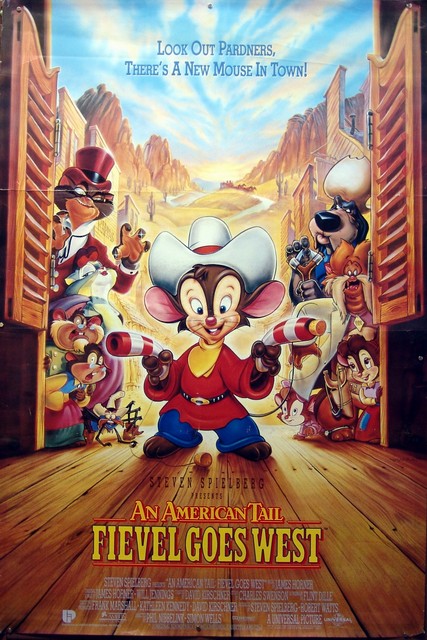
EXAMPLE #3: JUST RIGHT
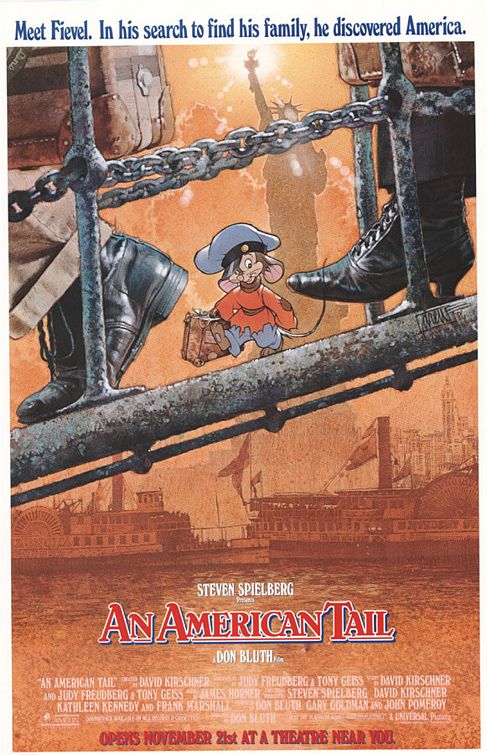
Of course, the easiest way to get more minority characters into American films is to hire minority writers. But that’s another story for another day…
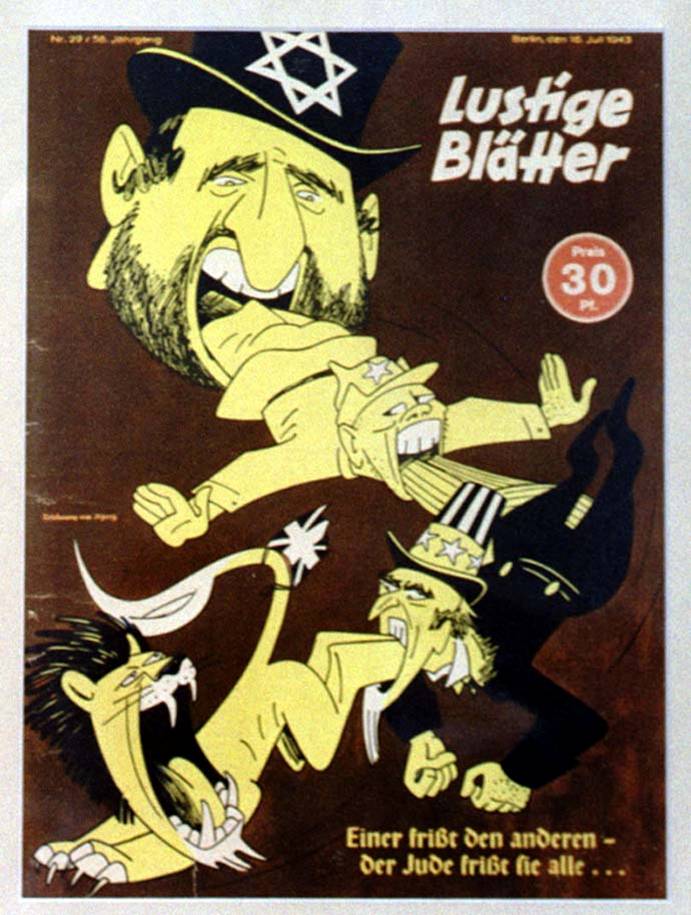
Can’t forget “Song of the South” when discussing race and Disney movies:
http://en.wikipedia.org/wiki/Song_of_the_south#Accusations_of_racism
Don’t try finding it a Blockbuster. Disney squashed US distribution of the film.
Actually, those three guidelines are pretty good for writing any characters, not just minorities…
Hey fft5305, where does French toast cost $53?
I disagree that the best way to get minority characters into movies is to hire minority writers. Most characters in movies are bad, and anybody can write bad characters.
I think the causality works the other way — minority characters leads to minority writers, not minority writers lead to minority characters.
The best way to do it is to hire more minority _actors_. If you wanted to make, say, the chief in _Get Smart_ black, you know what would be the best way to do it? Have him played by a black guy! You’d literally have to change nothing else, and it would be fine. The actor would take care of everything.
There’s no reason why the hero in John Q really has to be black — at least from the basic requirements of the script rather than the marketing or demand for the movie. But put Denzel in the movie and give him a black son and surprise! Problem solved!
Of course that doesn’t work for animated characters as well. But it’s not like writers are making the decisions about who ends up in Disney movies anyway. Those things are produced within an inch of their little singsong lives.
Good point, Fenzel. I should have been more specific, then. If Disney (or Hollywood in general) wants not only minority characters, but also cultural diversity in its films, minority writers would help.
Sure, you can just write a character and have them be played by a person of any race. But is that getting real cultural diversity into the movies? No. You’re just writing (predominantly) male white middle-class American dialogue and putting it into a minority character’s mouth.
I disagree that Disney should have just written a regular old princess movie set in fairytale Europe and then made all of the characters black. It’s not the worst thing they could do, but it’s analogous to the Cosby Show. (Shh, pretend we’re not black, everyone! Then we can appeal to every demographic!)
That all said, I wish Will Smith HAD played Neo in the Matrix like he was supposed to. That shit would have been tight.
I think, though, that Fenzel was trying to challenge the idea that some dialogue is intrinsically “male white middle-class American dialogue” while other dialogue is jive.
Which is to say, he’s pointing out the larger irony that arguments for “diversity” (however it is understood) fall prey to the very essentialism that the identity politics they’re rooted in worked so hard to undermine.
I suppose I am now pointing it out as well.
Well, as my post tried to point out above, there’s a middle ground between essentialist racism and whitewashing. I’m not saying that Tiana should be going around saying, “Oh lawdy, chile” while eating fried chicken.
But the idea that white, male, middle class American authors of a certain generation are able to write characters that are raceless, genderless, and without culture sounds impossible. If a writing staff has all white, male, middle class American writers, the fact is that they are probably going to write characters that act and think like they do. It’s not that a piece of dialogue will “sound white” because it uses certain words or phrases; it’s that these films will naturally concern certain themes and character archetypes that are important to people living in a certain place and time. Sometimes those themes are timeless and transcend boundaries of race, ethnicity, gender, and so on. Other times, these writers think they are being timeless but are clearly writing within a certain cultural context that may not speak to members of other groups.
As a white girl, I can’t speak about the racial issues very well, but I can speak from the “girl” POV. Only 11% of writers in Hollywood were women in 2005, and only 7% of directors. Even if I didn’t know these statistics, I’d know just from watching movies that the film industry is run by men. Just look at the Best Picture nominees from last year. In some ways, pictures like “No Country for Old Men” and “There Will Be Blood” were timeless films that anyone could enjoy, but, from another point of view, they were movies by men, about men, and for men.
I’m not saying the producers of those films should have made romantic comedies instead or made Anton Chigurh female. But if there were more female writers, directors, producers, etc., there would likely be more movies that talked to people like my mother. For all my dislike of Juno (long story), at least it had a different kind of voice.
Oh, goddammit. This is the second time today I’ve written a long reply and clicked submit and the site has crashed before posting it.
I guess I’ll try to reconstitute it:
Steel Magnolias
Sophie’s Choice
Atonement
“Before He Cheats”
“Total Eclipse of the Heart”
“It’s All Coming Back to Me Now”
All written by white dudes
“Shoop Shoop” from Waiting to Exhale
How Stella Got Her Groove Back
“Whatta Man”
All written by black dudes
You can narrativize after the fact how you can tell these are all written by dudes, but it’s very hard to tell ahead of time which are written by dudes and which are not (Would you be able to tell that “Steel Magnolias” is by a dude, but “Fried Green Tomatoes” is by a woman just by watching them? I doubt it.).
And in fact, that’s all this exercise is — narrativizing after the fact to try to find a neat explanation for something that is not nearly so neat and not nearly so explicable — the creative process.
Race and gender are constructions, and thus not natural. Therefore, very little, if anything, proceeds from them “naturally.”
The whole misunderstanding is motivated by three essential problems
1. The naturalistic fallacy — that matters such as where or in what circumstances someone is born is in itself normative. (Oh, they have an effect, but it does not have an inherent purpose, and it doesn’t give rise to a coherent teleological system; that is exactly the sort of fiction that racial superiority theories look to create.)
2. What Naseer Taleb refers to as the “Great Intellectual Fraud” — that is, the misapplications of Gassian notions of probability to human endeavors that are not governed by Gaussian distributions, but where in fact almost the whole of meaningful contribution comes from extreme outliers — also known as the “fat tail” phenomenon.
(That is, Hollywood writers are such a small subsection of the population at large and individual successes outweigh the net effect of literally millions of attempts; therefore statistical predictions are meaningless. If you like Sci-Fi, think of it as the “Mule effect” from Isaac Asimov’s _Foundation and Empire_ or I guess sort of related to the “Butterfly Effect” from that Ashton Kutcher movie.)
3. The illusions created by circles of readership that tend to align with self-identifying socioeconomic and ethnic groups. What appears to be cultural conditioning or an essential quality given to a group of artists that share certain specific perspectives and experience often has more to do with the specific other artists they are copying than with their identities in a demographic context.
A whole bunch of people who read a lot of Maxine Hong Kingston are going to have a lot in common with each other in their work as long as they’re all copying Maxine Hong Kingston. Chances are they are from similar backgrounds, but it’s not a causal correlation with their work itself, just with who they read.
In my previous post, I also listed a host of factors more influential than the social identity of the author in determining whether an effort to write a given character of a given ethnicity is going to be successful, including the insurmountable challenge of actually capturing an entire human being of any sort in writing, and especially the value of interpretation in collaborative art — that, again, if you want to put an Asian face on a character, just have that character played by an Asian actor. You really need very little else.
Developing talent across ethnicities and genders is a very good thing both for art and for the business of art. It’s actually quite necessary. But that has to do with maximizing fairness and opportunity — not shutting out potential genius and resources from opportunities to make art — and nothing to do with broad concerns of subject matter like we’re discussing here.
We want there to be more women who make movies, more black people who make movies, because we know that they can make good _movies_, not because we know they can make good movies about women and black people.
I mean, if we just want to keep them around to make movies about themselves and their own perspective, that’s not going to lead to any sort of meaningful advancement for anybody. That’s just ghettoization. That’s just more cultural isolation and preaching to the choir.
And I believe I ended my deleted post with:
“Rick Rubin! For Christ’s sake, Rick Rubin!”
Although I’ll end this one with,
“Ernest Tidyman! For Christ’s sake, Ernest Tidyman!”
Also, there’s a really cool story to be told here about how many of the classic “white” characters were invented by Jewish writers at a time when Jews were not considered very “white” at all — the most notable I can think of off my head being the superhero and the blonde bombshell.
I think we’ve lost sight of the main point, which is that there are no cats in America.
While the best reasons to hire more minority writers may not have to do with the broad subject matter of the art that is eventually produced, it would be an extremely effective way to redress the balance . Or rather to create a balance that was never there in the first place. The odds that a randomly selected character in a book or movie is going to turn out to be a white hetero male are way higher than they should be. (Women make up slightly more than half of the population. Each of the serious contenders for the Best Picture Oscar last year had precisely one legitimate female character.)
Re: “if you want to put an Asian face on a character, just have that character played by an Asian actor.”
First of all, that doesn’t apply to the male/female thing at all: those decisions are made at the level of the script. Second, if it does work for race – which is arguable – that just means that there should be more casting directors of [insert ethnic background]. Is that because they have the magical ability to recognize talents of all shapes and colors? No, it’s because they are less likely to commit the unconscious racism of assuming that the character should be a straight white man.
The main point there is that the ethnicity of a given character is much more likely to be a production decision than a writing decision.
And when it’s a writing decision, if it doesn’t go the way you like, and you’re a producer, just tell them to change it, and they will, no matter who they are.
By the way, as a side note I will offer up that I believe Fievel Goes West has the singular most hilarious scene in any animated movie. Ever. And I stand by that statement. I am, of course, refering to the one where the dog tries to teach the cat how to do the “laaazzzy EYE” and all hell breaks loose.
I’m chuckling about it even now.
My major problem here is that now a billion babies will have my name. I really liked having a lesser used name. this princess had better be friggin awesome. she’s representing my name and my race.
This is one of the DUMBEST controversies I’ve ever heard! Basically, Disney is trying to make a Black Princess but whatever mother community is mentioned in the post is giving them flack? Yeah, THATS gonna make Disney want to explore African-American culture in there movies more.
As for some of the complaints? So what if Randy Newman is the Musical composer? He’s been doing work with Disney for YEARS! Just because the character of the cartoon aint his color, he shouldnt be allowed to work on it? Also, how many Disney Princesses are ACTUALLY 3-Dimensional characters? Basically, these people are complaining to make the character (Which they have no creative stake in whatsoever)a more ‘High-Class’ character?